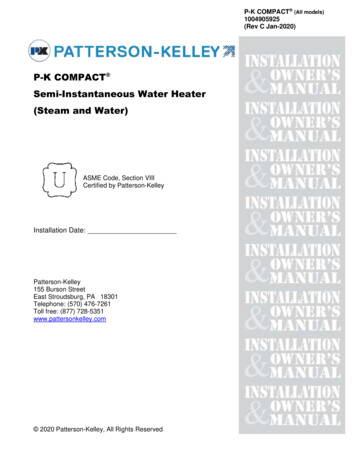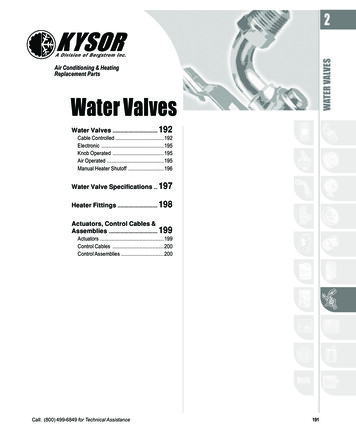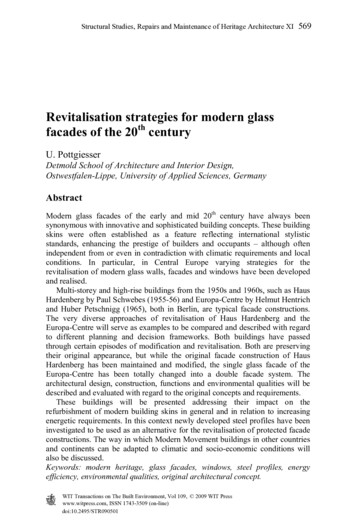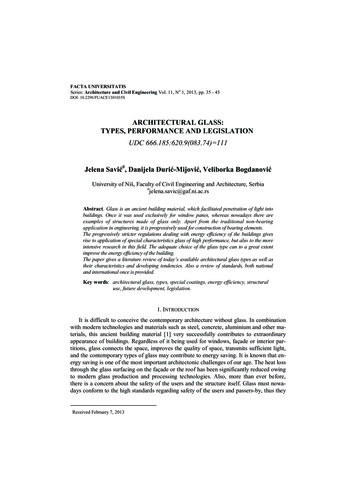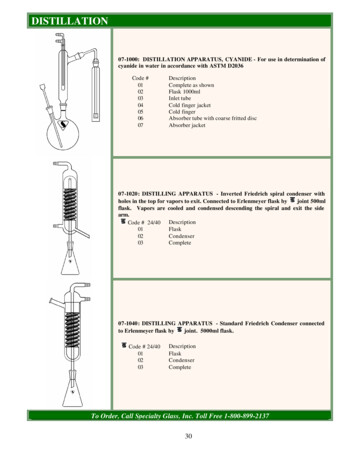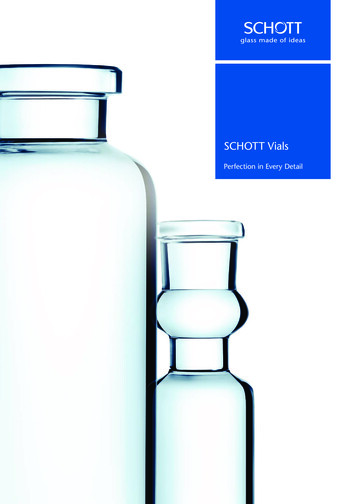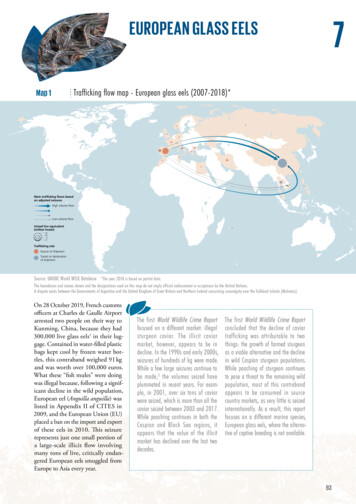
Transcription
IntroductionJune 2006My name is Bernhard and I live in Namibia. I have an FC project in mind [and have had since about 2003], whichcomprises a cluster of seven tetrahedrons with the outer members removed and the resulting hyperbolic paraboloidsurface covered in FC. As the surface will be open to atmosphere on both sides drying of the mortar is going to be aserious problem.There has been mention of Waterglass in the discussion list as an accelerator and also as a hardener/strengthener incementitious compounds so I did an Archive search, downloaded all the e-mails and then compiled the followingdocument.In my attempt to balance brevity and comprehensiveness, I have used my own discretion and have retained theauthor’s name at the top of each message [other than for the odd glitch or three]. Some of the info is not directly FCrelated and even goes off into thermal things about chimneys, making silica paints and the like. I have retained thesebecause they are needed to give context to the waterglas related comments made, and because they do link back toFC.In the processes of copying the e-mails from the Archive, I was not consistent and some have titles while others donot.Within the text of the messages, I have highlighted waterglass, sodium silicate and potassium silicate in all the placesthat I did not miss. In some messages I have highlighted a whole string of text because I found it all relevant.I hope some of you oldies, and especially newcomers, find this info useful.
-Water glass –Extracts from from FC.net Discussion GroupFrom: Richard Austin healthstyle@earthlink.net Date:2000-02-03Also.If you've seen the geopolymer site it incorporates both these ideas mentioned. Geopolymers are essentially a sol-gel chemistryof adding waterglass (either sodium or potassium based) to alumino silicates (clay).The result is an inorganic polymer which sets to full strength in minutes or hours depending upon temperature. Dr. Davidovits usesmicrowaves to rapidly harden the material.See more at: http://www.geopolymer.org/Gravel/sand/clay testFrom: "Loren" loren@ipa.net Date:2000-02-03Wayne,Really want to try something with the soil? Take a quart jar and put normal soil (no top soil, or organic matter) in the bottom third.Next fill with water to within 1 inch of the top and put the lid on and shake it and set it down and write down the measured amountthat falls out in the first 10 seconds--gravel, then 10 minutes--sand, then the next morning--clay Turn those into ratios and lets see ifwe can formulate an admixture to make it workable. I'll even send you some fibremesh if you want to do this. It is a polypropylenefiber which is wonderful in cement. I can eliminate layers of mesh by using this additive.Peter E.From: Richard Austin healthstyle@earthlink.net Date:2000-02-04From: "Loren" loren@ipa.net Date: Thu, 3 Feb 2000 22:45:11 -0600 Subject: [Ferro Cement] Re: Re: Re: Re: Re:acrylic mixDr. Richard,SNIPYes, I'm talking about using earth as a construction material by turning it into stone using waterglass (sodium silicate) orpotassium silicate. There is a way of making a foaming machine by adding Ivory soap to water, pumping air through tomake fine bubbles (aquarium bubblers) and feeding through a pipe (or hose) filled with kitchen scrubbers. Comes out likeshaving cream. This is folded into cement (or earth/silicate) and makes a foamed product.It looks like Davidovits may have a better way.A foamed product would be the core. Also, I'd like to use clay/stone for the strong shell layer as well. See the geopolymerpages I referred to earlier as well ndown.htm#pharoahApparently contaminants don't matter and lots of earth particles (every thing but clay) could be encapsulated by theclay/silicate reaction.The idea is to use the earth on site by evaluating the amount of clay and adding an inorganic reactant to change it intostone.How was Pliny making foamed earth?From: Richard Austin healthstyle@earthlink.net Date:2000-02-06His method is to combine waterglass with the raw materials to make it into rock again. Clay waterglass rock.From: "F. Marc de Piolenc" piolenc@mozcom.com Date:2000-02-07Making waterglass is relatively easy, and is similar to primitive glass manufacture. I have a procedure from an old soapmaking text(waterglass is a useful additive to soap), if anybody is interested. I can send it privately or to the list.Waterglass sets by exposure to carbon dioxide in the atmosphere or in the material being bound, so adding small amounts of acarbonate to the mix speeds up set quite a bit.Marc de PiolencFrom: Steve Millward millstev@isu.edu Date:2000-02-07
In the meantime I found the following tidbits while doing a search on sodium silicate. I thought the perlite might have someinsulation applications for our group. There is a place where they make perlite about an hours drive from me.Expanded perlite granules can be bonded to form rigid shapes for a very wide range of applications. The most suitable binder formany purposes is a liquid sodium silicate similar to traditional "waterglass". The liquid sodium silicates are solutions ofwater soluble glasses manufactured from varied proportions of Na2CO3 and SiO2, providing a wide range of chemical andphysical properties.Sodium silicates are widely used as high temperature adhesives and binders due to the following properties.Low costInorganicEasy to handleRapid controlled setHigh strengthInsolubility (when aired)Chemical stabilitySilicate-bonded perlite makes an insulation material which is completely non-flammable, the refractory nature of the bondbeing a major advantage.Potassium silicate is sometimes preferred for applications where heat insulation and fire resistance are the main objectives. Thismaterial has a slightly higher softening point than its sodium counterpart.Sodium silicate is widely used as a binder for molding sand in foundries. The technology for perlite/sodium silicatecomposite manufacture is based largely on this foundry industry experience.Perlite/Sodium Silicate TechnologyA wide range of formulations of perlite, sodium silicate solution and setting agent can be used, together with additives to control theabsorbency of the perlite and the speed of setting of the mix. General guidelines are given as a starting point.Soluble Silicate GradesThe choice of grade of sodium silicate solution depends on the application and setting process being used. Generally, a highersilicate to alkali ratio gives faster setting while lower ratios and higher solids contents give greater strength in the finished product.and also:Silica aerogel is fully dehydrated silica gel; it is very porous and is often used in insulation, e.g., for refrigerators.Cheers,Steve M.From: "F. Marc de Piolenc" piolenc@mozcom.com Date:2000-02-07Preparation of Silicate of Soda –Gossage prepares silicate of soda or silicate of potash by fusion, much in the same way as that adopted in the production ofordinary glass. He mixes together about equal parts of dry carbonate of soda and clean sand, to which is added one part by weightof ground coke or charcoal for each nine parts by weight of carbonate of soda. This mixture is melted in the same way as mixturesof sand and alkalies are in glass-making. The melted mass is afterwards poured into cold water, which renders it more friable. Theproduct is then ground to a fine powder, and afterwards dissolved by boiling in three or four times its weight of water. During theboiling liquid caustic soda is sometimes added. After reposing for a few hours the clear liquor is drawn off and concentrated byevaporation until it assumes a viscid condition suitable for mixing with pure soap.Preparation of Silicate of Potash. -In making silicate of potash, twelve parts of dry carbonate of potash, two parts of sand, and onepart of coke or charcoal are mixed together, and the whole melted and treated as above. In place of sand, ground felspar may beused, in which case three parts of this mineral are substituted for two parts of sand, and only one-half the quantity of alkali is used.Sulphate of soda or sulphate of potash may be used instead of the carbonates of soda or potash in making the "soluble glass," inwhich case three parts of either sulphate are substituted for two parts of either carbonate, and four times the quantity of coke orcharcoal above given.From: Richard Austin healthstyle@earthlink.net Date:2001-03-02 It took me awhile but I have confirmed that a Canadian company with the sawcrete blocks preserved with a siliconizingprocess is just using water glass, 1%. The french Hemp Co. alluded to that, and that their secrete process was "better". Well 50years and the Canadian stuff is still standing, so that will do for me.Alan,Are you saying that the addition of 1% waterglass reduces the alkalinity of concrete to make bio-reinforcement possible withoutdegradation? If so, it would open the door to polyester as well.Peace and Health,Richard
From: fractional@willmar.comDate:2001-03-02Hello Richard,I presumed the water glass was preapplied to the sawdust (and possibly dried?) before exposure to the cement mix. Not being achemist I don't know what liquid water glass would do to the alkaline nature of the mix but I doubt it would change that. It's referredto as a preservative, not an alkalinity modifier. That is possible with very involved CO & CO2 techniques, perhaps many others,but none that are do-able or affordable. Sodium silicate will soak into natural fibers like "water", of course there is substantialwater there. If you have had the misfortune of using a "plastic" bath towel you already know it will not absorb moisture. We canpresume the water glass would sit on the surface till it flaked off.There is some web based literature on the supercritical treatment of cement concretes for ultra high strength, and alkali abatement.Even more in the patents.However JUTE string would suck it up very nicely. That went right by me, glad you mentioned it. I used to wind up a few italiancan shells with jute string, incredibly tough stuff, and NON stretchy! It also has a great fibrous texture to grab onto the matrix with.The source of Jute escaped me but an initial search didn't help either. BUT I did find a source of Jute Geotextiles!http://www.jute.comLook under products/geotextiles. They estimated UK L .40 to .80/sq-yd. So the price is good, but several layers would be needed.But it's a thought. It would be flexible if woven, suitable for organic shapes. Some of the burlaps I've used have been weak, do youknow what fiber is used in burlap?AlanFrom: "Martin Iorns" miorns@att.net Date:2001-03-19Hey, Nolan! Yes, I've used a lot of foam, but not to replace the laminated reinforcement. You cannot use foam INSTEAD oflaminating, but foam DOES make an excellent core for the laminate.The 15-ft-wide decks of our 55-ft Valeo series boats contained 1-ft x 2-ft x 1-in-thick blocks of rigid urethane foam sandwichedbetween one layer of 3.4# expanded metal lath and 1-in x 1-in 14-gauge welded wire fabric. Shear ties are placed around theperimeter of each block to hold the upper and lower laminate together. In marina floats that are too small for persons to work inside,we laminate any type of mesh over blocks of expanded styrene beads. Laminates can also enclose cores of styrofoam, perlite,paper, saw dust, or other filler material bonded with waterglass or another adhesive compound.Martin E. Iorns, F.I.F.S., Industrial EngineerSpecialist in concrete and ferrocement construction methods1512 Lakewood Dr., West Sacramento, CA 95691-4040Telephone: 916-371-4561, Fax: 916-372-8290miorns@att.net www.ferrocement-consultant.com----- Original Message ----From: Nolan Scheid nolan@clipper.net Sent: Saturday, March 17, 2001 3:26 PMSubject: [Ferro Cement] Foam cores and Martin's lamination methods Hey Wayne, Go the next step. If you used cheap foam inside of Martin's lamination methods, you would have a verystrong insulated structure. I wonder if Martin has laminated over foam?N.From: Herbert Crow wcrow@telepath.com Date:2001-03-19Hey, did I say Mr. Irons was a gold mine or what? This is great! My only problem now is I see about 6 new solutions I would love totry, but don't have enough space for 6 tool sheds, lol. Give me some time, I might figure out how to test all these ideas in one or twotool sheds yet. Hey, can anyone tell me if waterglass is suppose to be one word or two? I seem to be finding it both ways. I amguessing it is one word since it represents a compound. I need to get some of this stuff and try it.Anyone else playing around with waterglass? I know we have talked about this off and on, but I do not remember anyone talkingabout testing various mix ratios. I also do not remember anyone talking about the longevity of the compound in mix or out. I seem toremember it is a good water proofer and am wondering now if it is one of the primary ingredients in the various brands of watersealers for wood and other construction materials. If it is, it does not seem to seal as well, or as long as I first thought.WayneFrom: Keith Britton brittons@maxinter.net Date:2001-03-19Hi WayneI've been fooling with waterglass the last couple of weeks. I bought a gallon in '88 and have been using small amounts from it overthe years for ceramics stuff. I'd been intending to use most of it this year experimenting with concrete densification and deeppore sealing but had to get it out to revive some high temperature cement which was needed for major kiln repairs. I was realunhappy to find that the viscosity seemed much lower than expected, and stirring brought up a heavy deposit from the bottom
which looked like it might be precipitated silica. If you know or pick up anything on shelf life, aging process or tests forconcentration, I'm interested. The Perlite Institute notes perlite/waterglass as a cement, and it seemed a good time to try that. Idribbled some onto ag. grade
shaving cream. This is folded into cement (or earth/silicate) and makes a foamed product. It looks like Davidovits may have a better way. A foamed product would be the core. Also, I'd like to use clay/stone for the strong shell layer as well. See the geopolymer pages I referred to earlier as well as:
